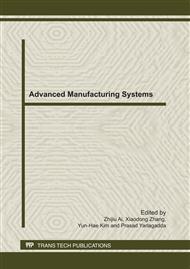p.444
p.448
p.452
p.458
p.462
p.477
p.483
p.487
p.491
Experimental Correlation between Metallurgical Parameters, Hardness and Machinability of 319 Al-Si-Cu-Mg Alloys
Abstract:
An attempt has been made to quantify the effects of alloying elements and aging parameters on the hardness and machinability of heat-treated 319 alloys containing α-Fe or β-Fe intermetallics An understanding of these parameters would help in selecting the metallurgical conditions required to achieve the optimum and maximum productivity at high speed machining. Hardness measurements were carried out on specimens prepared from 319 alloys in the as-cast and heat-treated conditions, using different combinations of grain refining, Sr-modification, and alloying additions. Aging treatments were carried out at 155°C, 180°C, 200°C, and 220°C for 4 h, followed by air cooling, as well as at 180°C and 220°C for 2, 4, 6, and 8 h to determine conditions under which specific hardness levels could be obtained. Statistical design of experiments is a satisfactory method for quantifying the effect of various parameters. Experimental correlations of the results obtained from the hardness measurements are analyzed and correlations that relate the alloying additions and heat treatment to the hardness of such alloys are found. Two levels of magnesium content (%Mg), volume fractions of the Fe-intermetallics (%V.F), Sr-modification (Sr-ppm), aging parameters (temperature and time) were tested: 0.1% and 0.28% for Mg, 2% and 5% for Fe-intermetallics (%V.F), 0-ppm and 200-ppm for Sr-modification, 180°C and 220°C for aging temperature and 2h. and 8h. for aging time. Experimental correlations between the metallurgical parameters and the machinability values obtained were analyzed. For this, two levels of Mg (0.1 and 0.28 wt%), Fe-intermetallics (2% and 5%), and two aging temperatures (180°C and 220°C) and aging time of 2h were selected.
Info:
Periodical:
Pages:
462-476
Citation:
Online since:
September 2011
Authors:
Price:
Сopyright:
© 2011 Trans Tech Publications Ltd. All Rights Reserved
Share:
Citation:


